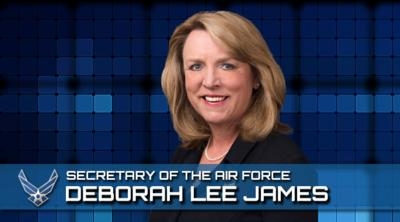Will Be Established At Seymour Johnson AFB In 2017
The Air Force will stand up an Integrated Wing pilot program at Seymour Johnson Air Force Base, North Carolina, according to Air Force Secretary Deborah Lee James.

"The Air Force remains on its flight path toward increasing our effectiveness and efficiency as an integrated total force service while meeting our nation's military objectives," James (pictured) said. "The Integrated Wing concept is an opportunity to more fully integrate and break down barriers between the components as we operate as one Air Force."
The I-Wing concept evolved from an extensive review and analysis of Congress’ National Commission on the Structure of the Air Force report, originally delivered in 2014. The I-Wing is an in-garrison model designed to better leverage the strengths of each component while balancing capacity, capability and readiness. Although there are several possible I-Wing models, all are designed to functionally integrate similar organizations and streamline chains of command in order to more effectively meet mission requirements. In our current fiscally constrained environment, initial analysis suggests this new total force construct could help the Air Force more effectively provide mission capability and capacity at best value.
The I-Wing is scheduled for initial operational capability in fiscal year 2017. If successful, this model has the potential, together with the highly successful unit associate program, to offer home station commanders another organizational construct to meet mission requirements. The testing phase is expected to take three years, but planners will adjust the timeline as necessary. Lessons learned from the initial I-Wing testing will influence the scope and timing of follow-on locations.
“We are excited about this opportunity to test our highly successful active association at the 916th (Air Refueling Wing) with a new Integrated Wing model,” said Lt. Gen. James F. Jackson, the chief of Air Force Reserve. “This pilot program will determine whether additional synergies can be garnered at this unit during the test and whether any lessons learned are repeatable at other locations in the Air Force.”
The I-Wing structure will not be identical, nor implemented, at every location due to the complexities inherent in each organization. It is also not designed to replace successful unit organizations. Factors such as location, mission, airframe, and composition will necessitate tailoring the exact structure and framework to effectively accomplish the mission while still taking care of our Airmen and families.
Currently, Air Reserve component and active component Airmen are working together in an active association at Seymour Johnson AFB. The 911th Air Refueling Squadron, an active component tanker unit, functionally falls within the organization of the 916th ARW, an Air Force Reserve Command wing, but reports administratively to the 6th Air Mobility Wing at MacDill AFB, Florida. Under the current construct, the organizations work together but are administratively separate, with two corresponding chains of command. In the new I-Wing model, all units will effectively function as a single organization to accomplish the mission.
"The Air Force is always looking for ways to better integrate our components, from the Air Staff to the tactical level. It's all about making the Air Force more effective and efficient," said Air Force Chief of Staff Gen. Mark A. Welsh III. "We believe the Integrated Wing is one of the concepts that will take us to the next level of that effort."
Specific implementation details, such as final wing structure, unit manning documents, and required exceptions to policy are still in concept development, and courses of action will be finalized prior to the I-Wing’s initial operating capability date.
(Source: USAF news release. Image from file)
 Unfortunate... ANN/SportPlane Resource Guide Adds To Cautionary Advisories
Unfortunate... ANN/SportPlane Resource Guide Adds To Cautionary Advisories ANN FAQ: Turn On Post Notifications
ANN FAQ: Turn On Post Notifications ANN's Daily Aero-Term (04.29.24): Visual Approach Slope Indicator (VASI)
ANN's Daily Aero-Term (04.29.24): Visual Approach Slope Indicator (VASI) ANN's Daily Aero-Term (04.28.24): Airport Marking Aids
ANN's Daily Aero-Term (04.28.24): Airport Marking Aids ANN's Daily Aero-Linx (04.28.24)
ANN's Daily Aero-Linx (04.28.24)



